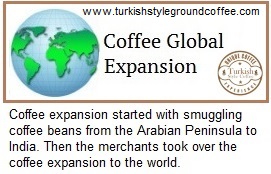Turkish Coffee Definition - Matters for Investigation
 Turkish coffee definition involves two matters that someone must look upon.
Turkish coffee definition involves two matters that someone must look upon.
The very first one is the basic question: “What is Turkish coffee?”
This is the most usual question that people unfamiliar with the subject ask.
The second definition has to do with its making method.
First of all we have to clarify that we are talking about ground coffee that is one of its kind. It is a fine powder coffee.
Second thing to define is that Turkish coffee is a brewing method. Actually it is the oldest one.
Turks were the first who developed this making procedure around 1600 AD. (More details in my Turkish coffee history webpage).
![]()
Turkish coffee definition - What is it?
In order to derive an answer you have to understand a few basics about this type of coffee:
(a) There is no variety of Turkish coffee bean. Turkey is a Mediterranean country and doesn’t grow coffee trees (tropical zone countries).
(b) The grind of the coffee is a unique characteristic of this coffee. It creates the necessary foam and then drops at the bottom of the cup as a left-over.
(c) The final result of this coffee preparation should be a frothy coffee (usually strong) with an exceptional aroma.
The following YouTube video tells you all about what Turkish coffee is in approximately 2:30 minutes.
![]()
How do you prepare Turkish style coffee?
 The general term of Turkish coffee clearly states a preparing method of a unique type of coffee.
The general term of Turkish coffee clearly states a preparing method of a unique type of coffee.
Turkish coffee is the only type of coffee that cooking takes place during its preparation.
Here brewing means actually simmering the coffee on a heat source (preferably gas or much better hot sand!).
This is the major difference of Turkish coffee to the other brewing methods (Espresso, Drip filtration, French press, etc.).
Other dissimilarities include the following:
(a) Thick-rich foam on the top (it resembles espresso but totally different taste).
(b) The coffee grounds at the bottom of a cup (French press has no actual comparison in this case).
How do we make Turkish coffee?
Here is an outline of my popular webpage’s recipe:
- Get your Turkish style coffee. (Ready pre- ground or by grinding roasted coffee beans in a Turkish mill).
- Mix coffee with cold water (1 teaspoon for each cup) and sugar/spices (both optional & depending on taste), in an appropriate Turkish pot.
- Place the pot on low heat.
- Stir the ingredients very well.
- Let it cook for a while.
- Before the coffee reaches the boiling point, remove the pot from the heat source.
- Allow for a few seconds the froth to settle down.
- Repeat the rising procedure for 2-3 times.
- Divide foam among Turkish coffee cups (demitasse) using a teaspoon.
- Pour the coffee liquid carefully in the cups, so that you don’t ruin the foam.
- Serve with a glass of cold water.
- Accompany with a Turkish delight.
NOTES:
-
- You don’t need spoons (You add sugar in the beginning of the brewing process)
-
- No need for milk (It’s a black coffee).
-
- Turkish coffee definition means foam on the top of the cup. It’s an exclusive characteristic of this type of coffee. If you can’t produce enough quantity for all the guests then it’s a failure. Or a… non-successful attempt to say the least.
- Turkish coffee definition means foam on the top of the cup. It’s an exclusive characteristic of this type of coffee. If you can’t produce enough quantity for all the guests then it’s a failure. Or a… non-successful attempt to say the least.
- The grounds remain at the bottom of the cup. They are not drinkable. You can use them though for…fortune telling.
![]()
Turkish coffee under different names
Another minor Turkish coffee definition issue is involved with the name “Turkish coffee” itself.
This hot caffeine beverage used to be the only type of coffee that many regions of the world knew. Middle East, Arab peninsula, Balkans, Caucasian countries, East Mediterranean and North Africa are just a few of them.
Nowadays, the phrase “Turkish coffee” nowadays has changed in many countries. They call it with their characteristic nation’s name instead.
Some examples you can see in instances like Greek coffee, Israeli coffee, Armenian coffee, Lebanese coffee, Serbian coffee etc.
The inhabitants of these countries just call it “coffee” or “black coffee”.
Each country has its own version of blending and roasting coffee beans. But they all share common set of general rules regarding to its preparation steps and serving manners.
Visiting my popular webpages of Greek and Israeli coffee you can understand exactly the details of this matter.
Each of them is full with details about rituals and other cultural matters that represent each country.
![]() - - RECOMMENDED ARTICLES - -
- - RECOMMENDED ARTICLES - -
 |
 |
 |
|||||
 |
 |
 |
|||||